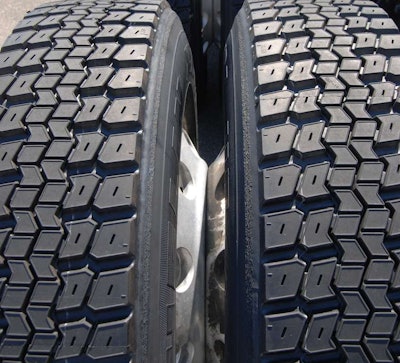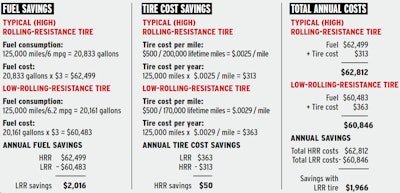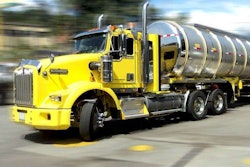 Smart spec’ing can keep one of your top expenses – tires – at a minimum.
Smart spec’ing can keep one of your top expenses – tires – at a minimum.Just as a truck with improperly geared rears will incur extra costs for its owner, so, too, will a truck with the wrong tires. Many more factors than size account for having the right tire for a specific truck in a specific application. Among variables to consider are size and number of plies and related weight rating, tread design, tread depth, tread compound and wheel position (steer, drive, trailer).
All play a role in proper spec’ing, and smart spec’ing can save money in two ways: reducing tire cost per mile and fuel cost per mile. Attributes that reduce one cost can have the opposite effect on the other cost, so tread carefully. That’s easier said than done at a time when specialization abounds. Tire makers have moved in recent years toward products that are focused to precisely meet specific service needs.
Since longer tire life means lower costs, the effort put into careful spec’ing will pay off well. The four main tire applications are long haul, regional, on/off-road and urban. The different applications mean different tire lives, from as little as 20,000 miles for urban to more than 200,000 miles for a long-haul team.
If you’re spec’ing a new truck, you can pick any tire size suitable to your application. A new truck’s drivetrain and engine controls are set according to the spec’d tire size. Replacement tires, however, may require drivetrain and engine adjustments. Changing tire sizes also might cause clearance issues.
More isn’t always better. Rather than last longer, tires with deeper tread might wear faster, burn more fuel and make driving harder if they’re applied wrongly. And the traditional miles-until-removal measure of tire performance more often now plays second fiddle in long haul to picking tires based on fuel economy. Some regional fleets are going to long-haul steers for low rolling resistance rather than tires with more scrub resistance designed for regional operation. The tires may wear faster, but they save enough in fuel to more than cover the extra tire replacement costs.
Consider this common tractor-only scenario: The steers have a 125 rolling-resistance rating, the drives are at 137, and the truck gets 6 mpg. Replacing steers and drives with lowest possible alternatives for RR rating (97 and 86) improves fuel economy to 6.52 mpg.
While shallower tread depth equates to better fuel economy, it also usually means shorter tire life. The good news is tire manufacturers are using technology to counter this inherent tradeoff, using different compounding and silicate makeups to help enhance life.
LOW-ROLLING-RESISTANCE TIRE SAVINGS
The example assumes a truck running 125,000 miles a year and diesel at $3 per gallon. It assumes a low-rolling-resistance tire that gets 6.2 miles per gallon and lasts for 170,000 miles, and a high-rolling-resistance tire that gets 6.0 miles per gallon and lasts for 200,000 miles.
In this example, the low-rolling-resistance tire is the more cost-effective choice due to a fuel savings that is much greater than the cost penalty of a shorter lifespan. However, because fuel economy and lifespan vary from model to model and are affected by application and other factors, savings also can vary considerably.

OTHER SMART TIRE SPEC’ING PRACTICES
SHOP FOR THE BEST VALUE. Get the most for your money, whether you spend a little or a lot. It’s tempting to shop primarily by sticker price, but cost per mile and retreading potential are more important considerations. Making an informed choice means keeping written and dated records of purchase, fuel mileage and tread depth, then comparing records between models you’ve used. Consider warranty in any value calculation.
USE RETREADS. Premium tire makers design casings for retread use. New tires today can be retreaded up to four times after their initial tread life ends. The cost of a retread tire is half that of a new tire – or in some cases even less than half. On the downside, some carriers and state governments restrict retread use on steer axles. And not all retreads are created equal. If the retread isn’t from a reputable dealer, or if its markings have been scrubbed off the side, think twice before buying. Tips on starting and maintaining an effective retread program follow:
•Partner with a top-quality retreader you can trust to ensure reliable products and good warranty support. The Retread Tire Association can supply a list of reputable retreaders in your area.
•Purchase the best tires you can afford to deliver long casing life.
•Monitor tread depth. Steer tires should be retreaded at 6/32nds depth, drive and trailer tires at 5/32nds.
•Stick to a tire-maintenance plan to preserve the casing. Assuming no road damage to the tire, it’s not uncommon for an owner-operator to retread a drive tire twice, getting three lives in the drive position.
USE WIDE SINGLES. Wide singles weigh less and save fuel. One also costs less than the two tires they’re designed to replace, although you have to buy new rims to get in the game. Wide singles are retreadable, too. With a fuel-efficiency gain of 4 percent due to the reduced rolling resistance singles offer, though, the nearly $2,000 yearly fuel savings will pay for the new wheels and tires in less than three years. If you’re in a payload-sensitive application, the weight savings could yield bigger revenue, reducing that time period dramatically. An automatic tire inflation system can address the most common complaint about wide singles – inability to “limp” to the next service site with a flat – by keeping tires inflated to proper pressure.
GO LOW-PRO. For long-haul on-highway applications, a low-profile tire set-up with a shorter height than width offers advantages in fuel efficiency, handling, weight, overall truck height and tire life over more standard configurations. The aspect ratio – sidewall height measured in a percentage relative to its width at its widest point – of the most common 11R22.5 tires is about 100 percent, meaning the sidewall height and width are the same. Low-pro tires’ aspect ratio is about 80 percent with size designations such as 295/75R22.5.
PRACTICE GOOD HABITS FOR LONG TIRE LIFE
PERFORM ROUTINE MAINTENANCE. Proper maintenance of tires, wheels, axles and the steering column will help keep your tire costs down. Wheels naturally lose alignment and balance. Bushings, shocks, bearings and valve stems wear out. Checking wheel alignment periodically can pay big dividends. Whenever you start seeing a heavy spot or a flat spot, the tire has ceased to be centered on the hub, and it’s beading out of round. Whenever you need to scrap a tire, inspect it to determine the cause of the failure, and record the event.
The plungers inside shock absorbers create friction, and friction creates heat, so if the shock – not the outer dust barrel covering the top half of the shock – is hot to the touch after driving, it’s working. If it’s cool to the touch, it’s not working and should be replaced. Make sure bushings at the top and bottom of shocks are inspected and replaced whenever worn. If you can grab the shock absorber and rattle it, the bushings have pounded themselves out.
MAINTAIN PROPER INFLATION. Ironically, maintaining correct inflation is free and relatively easy, yet it’s the highest-saving maintenance you can perform on your truck. Improper inflation is by far the greatest reason why tires fail or wear out prematurely, also wasting fuel. Daily pre- and post-trip inspections give owner-operators the opportunity to check pressures and also look for leaks, punctures, broken valve stems or embedded objects such as nails. Even absent damage, truck tires typically lose one to two pounds of pressure a month from normal use. A slow leak such as a puncture might cost you one to three pounds of air a day. For each pound of air pressure lost, a tire’s on-road temperature rises about 2 degrees, and hot tires are prone to losing tread more quickly and failing. Don’t overinflate, either; an overinflated tire sustains rapid and irregular wear and is more susceptible to damage from running over debris and scrubbing curbs.
Some operators use aftermarket tire sealant products both as a safeguard against punctures and to help maintain proper inflation pressure. At least one tire manufacturer, too, markets a line of highway truck tires with sealant built-in from the factory. A quality sealant will have been tested extensively, and its dealer should be able to provide testing documentation. If you’re considering such a product, don’t hesitate to ask for this.
EMPLOY GOOD DRIVING HABITS. Speeding, hard braking, curbing and tight turns cause tires to wear faster or even develop irregular wear. On the other hand, steady acceleration, braking and steering can extend tire life. Many of the problems caused by bad driving habits show up as uneven tire wear. If you notice unusual shimmying or repetitive bumps, inspect your tires. Even absent rough driving, look for irregular tread wear in your daily inspections.
FIGHT IRREGULAR WEAR. Check axles and suspension components (bushings, tie rod ends, kingpins, shocks, etc.), replacing any that show excessive wear. On the steer axle, change your shocks at least as often as you change your tires. On the drive axle, get more aggressive, replacing shocks halfway through the tire’s life and when the tires are changed. Consider super-premium shocks, good for several hundred thousand miles, that can be rebuilt.
DOUBLE DOWN ON ALIGNMENT. Many people believe they should get new tires installed before they have a truck aligned. The opposite is true – take your truck to the alignment shop with the old tires on. That way, technicians can read your tire wear to learn what is wrong with the alignment and determine more precisely how to make adjustments that solve the problems. Also make sure your bearings are adjusted properly in all positions and check for proper mounting – a simple check. Look for a ring molded into the tire where the rim and tire meet. Measure the distance from the rim to that line at four points around the tire; each measurement should be within 2/32-inch. If the variance is greater, the assembly needs to be broken down and remounted properly.
Mounting should be followed with a check of the radial run-out (deviation of the tire from a perfect circle) and lateral run-out (deviation of the sidewall from a perfect plane). Both measure how well the wheel assembly is mounted on the hub. Good quality run-out gauges cost less than $100.
UNDERSTANDING TREAD BY POSITION
Tire choices are about compromise, particularly when it comes to spec’ing the right tread. In general, steer tires are usually rib-type tires with medium tread depth, while drive tires, when traction on snow or mud might be a factor, tend to be more aggressive with cross grooves (lugs) and deeper tread depths. If a fleet of over-the-road trucks never leaves Florida highways, the fleet would benefit – in both wear rate and fuel economy – from using rib tires on every wheel position.
STEER
- Four or five straight solid ribs support lateral forces created during normal handling and cornering and by wind drag.
- Tread pattern design and tread compound resists irregular wear in long/medium-haul service or is cut- and chip-resistant for on/off-road service.
- Tread depth delivers long tread life while offering low rolling resistance for greater fuel efficiency.
DRIVE
- Tread pattern designed with closed shoulder (shoulder ribs) for long-haul service to prevent irregular wear and provide good handling.
- Tread pattern designed with open shoulder (shoulder lugs) for regional operation, offering secure traction. Blocks in the central tread for all.
- Deep tread for long tread life, but a low rolling-resistance compound for fuel economy.
TRAILER
- Shallow tread delivers longer life and guards against irregular wear.
- Strong solid shoulders for strong dragging forces and scrub.
- Special compound reduces rolling resistance.
SEVEN TIRE KILLERS
Avoid these most-common tire threats to keep costs low.
1. UNDERINFLATION. A tire running on low air works harder than intended. The potential for damage accelerates the further the tire gets from optimum pressure.
2. OVERINFLATION OR OVERLOADING. Overloading a tire produces problems similar to those of underinflation. Never load a tire beyond its rating. Instead, adjust air pressure for the load and/or ambient temperature. Hot temperatures increase air pressure; cold reduces it.
3. POOR WHEEL ALIGNMENT. If wheels aren’t aligned correctly, tires aren’t rolling straight down the road, and wear will accelerate.
4. POOR SUSPENSION MAINTENANCE. Neglect of the suspension system will create a snowball effect, with the tire facing uneven stresses that change every few seconds, as well as a suspension system that simply cannot be brought up to spec.
5. IMPROPER MOUNTING/DE-MOUNTING. This would include using starting fluid or tools with rough edges, failing to clean the wheel or inspect the tire to make certain it hasn’t been damaged or overstressed, and replacing the core seal rather than reusing the old one.
6. IMPROPER REPAIR. Never allow a rope (patch) repair to serve as a permanent fix to a punctured tire.
7. TIRE UNSUITED TO THE APPLICATION. Only a few tires are designed to work in more than one position or application. The wrong tire or tread will not be nearly as durable as the right one.









